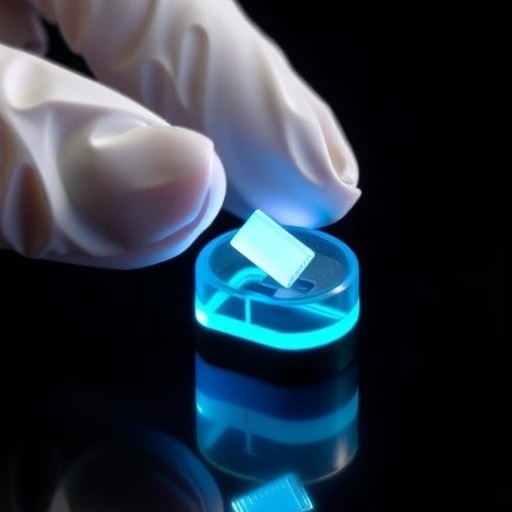In the ongoing quest for innovative and environmentally friendly detection methods in the realm of pharmaceuticals, a groundbreaking study has emerged, advancing our understanding of electrochemical detection techniques. This research focuses on the detection of ofloxacin (OFX), a widely used antibiotic, through the deployment of phosphorus-doped graphitic carbon nitride (PGCN)-modified glassy carbon electrodes. The implications of this study could significantly impact pharmaceutical monitoring and environmental safety.
Electrochemical detection presents a compelling approach for monitoring pharmaceuticals due to its high sensitivity, rapid response times, and cost-effectiveness. However, traditional sensing materials can pose limitations regarding selectivity and environmental sustainability. Enter phosphorus-doped graphitic carbon nitride (PGCN), a novel material that exhibits enhanced electrochemical properties compared to its predecessors. The integration of phosphorus atoms into the graphitic carbon nitride structure alters its electronic configuration, thus augmenting its catalytic capabilities and conductivity.
The significance of using PGCN-modified electrodes lies in their ability to facilitate the fast and effective sensing of ofloxacin, minimizing the potential for environmental contamination. With the global rise of antibiotic resistance, the need for reliable and efficient detection mechanisms is more pressing than ever. The electrochemical detection of OFX is not only efficient but also represents a sustainable alternative to conventional chromatographic methods, which can be cumbersome and resource-intensive.
To evaluate the efficacy of the PGCN-modified glassy carbon electrode in detecting OFX, the researchers conducted a series of experiments employing differential pulse voltammetry (DPV). This technique is particularly advantageous due to its ability to amplify current signals, allowing for the sensitive detection of low concentrations of the target compound. The study reports a remarkable detection limit, affirming the electrode’s potential in real-world applications where regulatory compliance necessitates stringent monitoring of pharmaceuticals.
One of the standout features of the study is its emphasis on environmental sustainability. By utilizing PGCN, the researchers have not only enhanced detection performance but have also aligned their methodology with the principles of green chemistry. This commitment to sustainable practices demonstrates a growing awareness within the scientific community regarding the environmental implications of research and the products that emerge from it.
The interaction between OFX and the PGCN-modified electrode was meticulously analyzed, revealing a strong adsorption mechanism that contributes to the enhanced sensing performance. Understanding the underlying electrochemical processes is crucial for developing advanced sensors that can be deployed in various settings, including clinical and environmental monitoring. The capacity to accurately detect antibiotic residues in waterways is particularly critical as these contaminants have detrimental effects on aquatic life and human health.
In order to validate their approach, the authors also conducted interference studies. These experiments assessed the selectivity of the PGCN-modified electrode in the presence of other common pharmaceuticals and organic compounds. The results indicated remarkable selectivity, underscoring the electrode’s potential to serve as a reliable tool for OFX detection amidst a complex chemical environment.
The study is a significant step forward in the field of electrochemistry, highlighting not only technological advancements in sensor design but also the imperative to prioritize environmentally friendly practices in scientific inquiry. By demonstrating that high-performance detection can coexist with sustainable methodologies, this research paves the way for further explorations into alternative materials that can be integrated into electrochemical sensors.
The findings of this research contribute valuable insights into the functionality of PGCN in electrochemical applications and offer a framework for future studies aiming to leverage similar materials for various analytes. The exploration of doping strategies, such as phosphorus incorporation, is particularly promising and could inspire a new generation of sensing technologies equipped to tackle pressing environmental issues.
With the rise in antibiotic usage and the consequent risk of environmental contamination, the need for efficient detection methods has become increasingly urgent. This study provides a compelling argument for the adoption of PGCN-modified electrodes as a viable tool for pharmaceutical monitoring, indicating that the intersection of technology and sustainability is not only feasible but necessary.
In conclusion, this research represents an important contribution to the field of electrochemical detection, underscoring the potential of phosphorus-doped graphitic carbon nitride as a transformative material. As we navigate the complexities of modern environmental challenges, the development of innovative, sustainable detection methods will be paramount in safeguarding public health and preserving ecological integrity.
Researchers and policymakers alike will find the implications of this work far-reaching, with potential applications in regulatory compliance, pharmaceutical manufacturing, and environmental monitoring. The advent of environmentally conscious scientific practices signals a crucial shift in how we approach the intersection of chemistry, technology, and sustainability in the contemporary world.
As the scientific community continues to push the boundaries of electrochemical research, this study stands out as a beacon of innovation and responsibility. The ongoing dialogue around sustainable practices in research is vital, fostering a culture of conscious inquiry that prioritizes both technological advancement and environmental stewardship.
In summary, the breakthrough achieved by Sharma, Bhardwaj, and Taunk extends beyond merely enhancing detection methods; it represents a holistic approach to scientific research, intertwining the urgency of monitoring pharmaceutical residues with the imperative of environmental sustainability. The future of electrochemical detection is indeed promising, driven by materials and methodologies that align with the principles of green chemistry.
Subject of Research: Detection of pharmaceutical residues using electrochemical techniques.
Article Title: Electrochemical detection of ofloxacin (OFX) using phosphorus-doped graphitic carbon nitride (PGCN)-modified glassy carbon electrode: an environment friendly and sustainable method.
Article References:
Sharma, Y., Bhardwaj, V., Taunk, M. et al. Electrochemical detection of ofloxacin (OFX) using phosphorus-doped graphitic carbon nitride (PGCN)-modified glassy carbon electrode: an environment friendly and sustainable method. Ionics (2025). https://doi.org/10.1007/s11581-025-06612-7
Image Credits: AI Generated
DOI: https://doi.org/10.1007/s11581-025-06612-7
Keywords: Electrochemical detection, ofloxacin, phosphorus-doped graphitic carbon nitride, sustainable methods, environmental monitoring.




